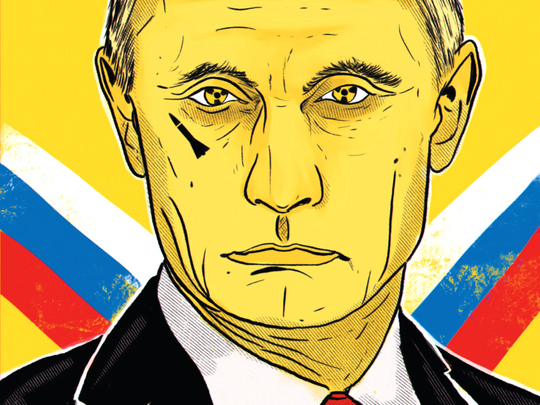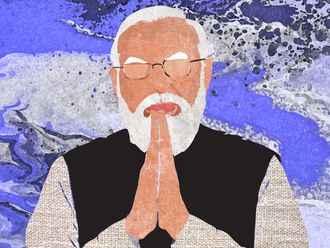
Russian President Vladimir Putin has made clear his priorities for his next six-year presidential term. In his annual state-of-the-nation address, he spent a good time talking about Russia’s new strategic weaponry.
Revanchism and confrontation continue to drive Putin’s agenda. He recognised that some of the ambitious goals he set before the 2012 election — such as increasing labour productivity by 50 per cent or drastically reducing poverty — weren’t achieved, but argued there would have been no progress had he not raised the bar.
These were enormous spending commitments in his speech. Putin didn’t explain how they would be funded and didn’t promise any structural reforms that might uncover hidden economic reserves. He just mentioned “new tax conditions” that the government would have to create without stunting economic growth. The president’s much discussed speech can be summed up in the following tweets by Sergey Aleksashenko, former deputy governor of the Russian central bank: “I know there are problems, we’ll solve them by throwing money at them. Where will the money come from? A niggling question, we won’t discuss it.
“There are tough problems, I know. It’s because bureaucrats aren’t doing a good job. I’ll show them!”
But Putin visibly came alive for the second half of the address, which was entirely devoted to Russia’s military resurgence and punctuated by computer-generated videos in the style of 1990s video games. These purported to demonstrate new weapons, which Putin assured his audience have all been successfully tested with some going into mass production.
These included several varieties of missiles, including a heavy ballistic one, Sarmat, and new types of cruise missiles all capable, according to Putin, of bypassing US missile defences. The cruise missiles would have an unlimited range, thanks to nuclear-powered engines, and the videos showed them dodging around the areas covered by US anti-missile installations. The audience whooped as the missile trajectories converged somewhere in the Western Hemisphere. Putin also bragged about nuclear-powered underwater drones that could go faster and travel much further than any modern torpedoes. No nation, he said, has similar weapons today, and they’re all built with new, post-Soviet technology.
This part of the speech carried a three-part message to western, primarily US, leaders:
n “We’ve never ceased to be a major nuclear power, but no one would listen to us. Listen to us now!” (This line was greeted with a standing ovation)
n If you believed Russia was permanently left behind after the Soviet Union’s break-up, you miscalculated: “Russia containment has failed.”
n The US anti-missile defence system and the expansion of Nato infrastructure to Russia’s borders are “ineffective and a useless financial burden.”
“This is not a bluff,” Putin insisted — a claim that I hope will never be tested.
Some Putin allies were enthused about the threatening part of the speech. Margarita Simonyan, head of the RT channel, noted: “If a US president delivered such an address, 99 per cent of the population and certainly the entire establishment would support it. Here, though, we get all this moaning and indignation — why the hell do we need these weapons, what an aggressive message. Why don’t you just get the hell out!”
I’m inclined, however, to agree with another Muscovite who — like me — now lives overseas, art dealer Marat Guelman, who posted: “I’m truly beginning to fear for the country. It’s not just a new burst of the arms race. It’s some kind of madness.”
The problem is not so much with the modern weapons — a country as big as Russia needs military strength — as with what the weapons are needed to defend. Without a clear vision of the future or an attractive model for others to imitate, without any soft power to speak of, without an economic model that can ensure sustainable growth or keep people out of poverty, the missile-rattling is terrifying. In the context of an election with a predetermined result, Russia’s growing military might means better protection for the regime.
Putin’s fascination with the new toys is understandable. But his mischievous suggestion that listeners suggest names for some of them (“Volodya”, Simonyan immediately proposed, using the diminutive form of Putin’s first name) has more symbolic meaning than the president put into it. Sarmat, Kinzhal (Dagger) and any new names “patriots” come up with for the weapons leave a question: Are these the only internationally recognisable brands modern Russia is capable of producing? If not, why can’t I remember any other ones?
Modernising weaponry is fine as long as the rest of the country also undergoes modernisation and sheds the features of a sluggish state. That’s a tougher job and one Putin knows is required; he just isn’t particularly excited about it — and so Russia is in for another six years of muscle-flexing and stagnation.
— Bloomberg
Leonid Bershidsky is a Bloomberg View columnist. He was the founding editor of the Russian business daily Vedomosti and founded the opinion website Slon.ru.











